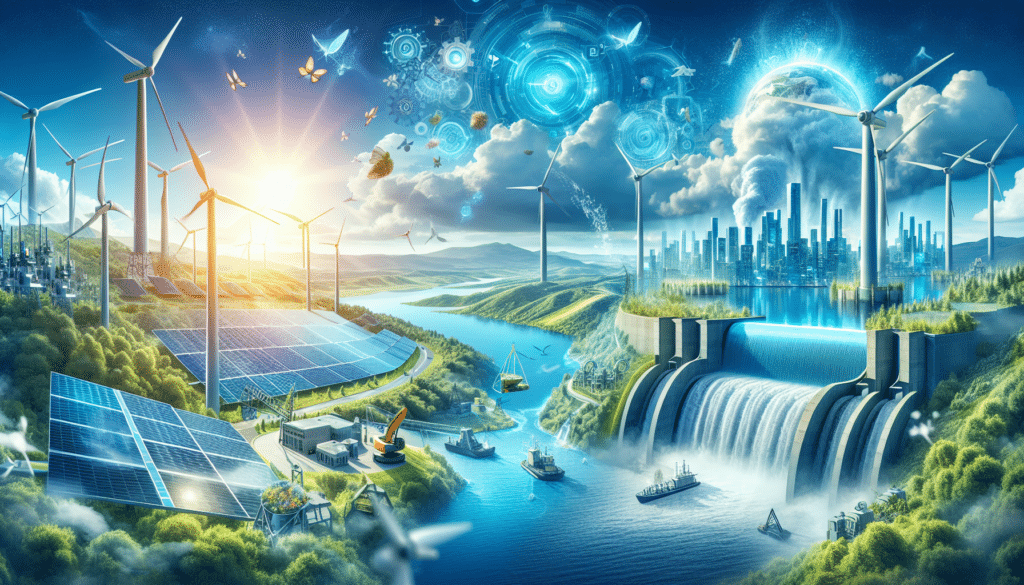The Future of Energy: Breakthroughs in Renewable Power

The energy revolution we are experiencing is more than just a shift in power sources; it's a complete transformation of how we generate, store, and consume electricity. Historically, humanity has relied on finite and polluting energy sources like coal, oil, and natural gas. Now, driven by climate urgency and impressive technological advancements, we are on the cusp of a future where energy is abundant, clean, and accessible to all.
This article will explore the most promising innovations shaping the future of renewable energy. We will discuss not only the technologies we already know, like solar and wind, but also cutting-edge breakthroughs in energy storage, nuclear fusion, geothermal, and other areas with the potential to redefine our world.
A Quantum Leap in Known Sources
1. Solar Energy: Beyond the Traditional PV Panel
Solar energy has been a driving force in the energy transition, but the future of the sector is far more dynamic than the silicon panels we see on rooftops today.
- Perovskite Solar Cells: Silicon has been the industry standard for decades, but perovskite, a semiconductor material, is emerging as a potential replacement. Perovskite solar cells are thinner, lighter, and, in theory, cheaper to produce. Current research is focused on increasing their durability to make them commercially viable.
- Transparent Solar: Imagine building windows and even your smartphone screen generating electricity. Transparent solar technology is becoming a reality, using materials that absorb wavelengths of light invisible to the human eye to generate power.
- Efficiency Improvements: Innovations in nano-engineering and materials are continuously increasing the efficiency of solar panels, allowing them to generate more electricity in less space. This is crucial for urban areas where space is limited.
2. Wind Energy: Bigger and Smarter Turbines
Wind power is also evolving significantly. Innovation isn't just limited to larger turbines, but also to how they operate and where they are installed.
- Floating Offshore Wind Farms: Most of the world's wind potential is in deep waters where conventional turbines cannot be installed. Floating offshore wind farms solve this problem, allowing turbines to be anchored far from the coast. This technology is in rapid development and promises to unlock vast new sources of energy.
- Bladeless Turbines: Researchers are experimenting with radically different designs. Bladeless turbines, which use wind resonance to generate energy, are quieter, require less maintenance, and could be installed closer to residential areas.
The Tipping Point: Energy Storage
The biggest challenge for intermittent renewable energy sources like solar and wind has been storage. The sun doesn't shine at night, and the wind doesn't always blow. Innovations in energy storage are what will truly make renewables the backbone of our power grids.
- Next-Generation Batteries: Lithium is currently the dominant material, but new battery chemistries are being explored to make them cheaper, safer, and more efficient. Solid-state batteries, for example, promise higher energy density and a longer lifespan. Flow batteries, which store energy in tanks of chemical liquids, are ideal for large-scale, long-duration storage.
- Gravitational Energy Storage: Companies are exploring the use of gravity to store energy. Systems that lift heavy concrete blocks when power is abundant and release them to generate electricity when demand is high are a low-cost, long-duration energy storage solution.
- Green Hydrogen: Hydrogen produced from electrolysis powered by renewable energy is a promising energy carrier. It can be stored for long periods and used to power heavy-duty transport, industries, and even the electrical grid.
New Frontiers and Emerging Technologies
1. Nuclear Fusion: The Star in a Box
Nuclear fusion, which mimics the process that powers the sun, has been the "holy grail" of energy for decades. Unlike nuclear fission (the current process), fusion produces no long-lived radioactive waste and uses abundant fuels. Significant recent breakthroughs, such as the demonstration of net energy gain at the National Ignition Facility, have rekindled hope that commercial fusion could be a reality in the future.
2. Advanced Geothermal: Energy from Earth's Core
Traditional geothermal energy requires a natural reservoir of hot water. However, Enhanced Geothermal Systems (EGS) use water injection to fracture hot rock and create an artificial reservoir. This technology could unlock geothermal potential almost anywhere on the planet, making it a reliable, 24/7 power source.
3. Wave and Tidal Energy: The Power of the Oceans
The oceans cover most of the planet, and the energy potential they hold is immense. Technologies to harness wave and tidal energy are becoming more robust and efficient. Tidal energy farms, which use the rise and fall of tides to turn turbines, are already in operation, and the development of more efficient devices to capture wave energy promises to expand the oceans' power generation capacity.
The Integrated Future: Smart Grids and AI
None of these technologies will operate in isolation. The real transformation will come from integrating these innovations into a smart grid that uses artificial intelligence (AI) to dynamically manage the flow of power.
- Energy Forecasting: AI can analyze weather data to accurately predict solar and wind generation, allowing grid operators to prepare storage systems and backup sources.
- Consumption Optimization: AI can optimize energy consumption in real-time, directing electricity where it's needed most and at the right time, reducing waste and costs.
- Electric Vehicles as Mobile Batteries: Electric vehicles can connect to the grid and supply power from their batteries back to the grid during peak demand (Vehicle-to-Grid, V2G technology). This turns the vehicle fleet into a vast, decentralized energy storage network.
Conclusion
The future of energy is not a single technology, but an interconnected ecosystem of innovations. From the next generation of solar panels and wind turbines to revolutionary technologies like nuclear fusion and gravitational storage, we are building the foundation for a world where clean energy is the norm. The transition will not be easy or quick, but with each breakthrough, we move closer to a more sustainable, resilient, and energy-abundant future for all.

Related